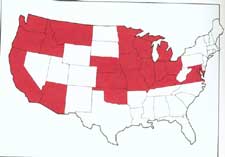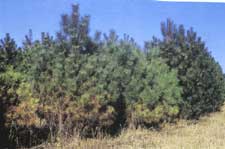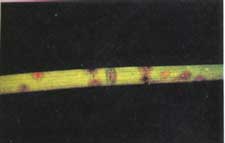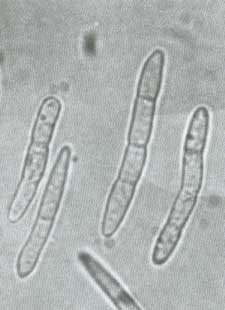Dothistroma Needle BlightGlenn W Peterson - Plant Pathologist (retired), Rocky Mountain Forest and Range Experiment Station, USDA Forest Service, Lincoln, NE. Cordell C.E., Anderson R.L., Hoffard W.H., Landis T.D., Smith R.S. Jr., Toko H.V., 1989. Forest Nursery Pests. USDA Forest Service, Agriculture Handbook No. 680, 184 pp.
Distribution The fungus occurs in 21 States, including Alaska (fig. 4-1). Mycosphaerella pini (syn. Scirrhia pini), the sexual state of the fungus, has been found only in Alaska, Oregon, and California. Damage Dothistroma needle blight does not seriously damage pine seedlings in nurseries. In plantations in the Central States, however, epidemics have developed within 5 years of outplanting with infected nursery stock. These epidemics have resulted in unmerchantable Christmas trees, reduced effectiveness of windbreaks, and increased maintenance costs in park and landscape plantings. Diagnosis On established pines, infection is most severe on the needles in the lower crowns (fig. 4-2). In the Central States, symptoms develop in the faIl (October or later) of the year that the needles are infected. Look for yellow or tan spots and deep-green bands. The spots and bands on the needles turn brown to reddish brown (fig. 4-3). These reddish bands are most distinctive on pines in the West, where this disease is often referred to as "red band" disease. Although the bases of infected needles remain green, the ends of infected needles usually turn pale green, then yellow, and finally brown. Needles may develop extensive necrosis 2 to 3 weeks after the first symptoms appear. Infected needles drop prematurely. The second-year needles drop first, before the current-year needles. Current-year needles of Austrian and ponderosa pine are initially resistant to infection, but they become susceptible in mid-July. Symptoms on seedlings are similar to those produced on established pines. Dark fruiting bodies are visible with a 10 x hand lens in the bands and spots on the needles. The epidermis characteristically is split longitudinally along two sides of the fruiting bodies, and a fragment of the epidermis adheres to the top.
Biology In the Central States, fruiting bodies of the fungus are formed in the late fall, but they do not mature and produce conidia until the following spring. Conidia are dispersed and infection may occur from May to October. In the West, fruiting bodies may form, mature, and release conidia during the same growing season. Infection occurs earlier in the season than in the Central States. Control Prevention - Remove infected pines on nursery grounds, or spray them with a fungicide. The infection of pine seedlings in nursery beds can be prevented by eliminating the sources of inoculum. Selected References Peterson, Glenn W. 1982. Dothistroma needle blight of pines. For. Insect & Dis. Leafi. 143. Washington, DC: U.S. Department of Agriculture. Forest Service. 6 p. Peterson. Glenn W.; Wysong. David S. 1986. Dothistroma blight of pines. In:Riffle. Jerry W.: Peterson. Glenn W., tech. coords. Diseases of trees in the Great Plains. Gen. Tech. Rep. RM.129. Fort Collins, CU: U.S. Department of Agriculture, Forest Service, Rocky Mountain Forest and Range Experiment Station: 120-121. |
Forest Pests: Insects, Diseases & Other Damage Agents |

|
|





